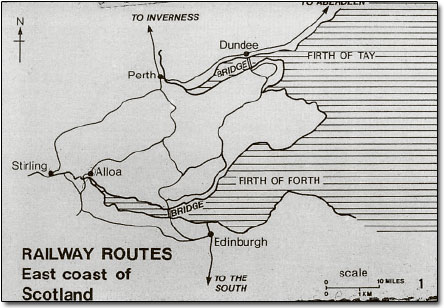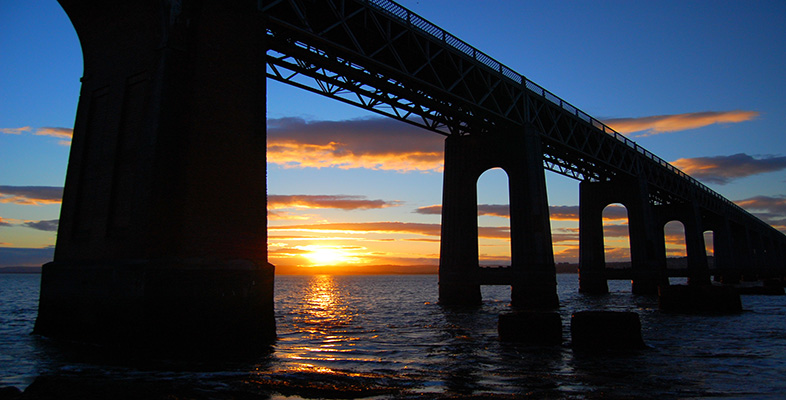3.2 Background
North of Edinburgh, in east Scotland, lie two great estuaries, the Firth of Forth and the Firth of Tay. The Firth of Forth begins at the ancient town of Stirling and runs 50 miles to the east, where it emerges into the North Sea. Edinburgh, the capital city of Scotland, is situated on the southern bank at the mouth of the estuary 30 miles east of Stirling (Figure 9). Eleven miles west of Edinburgh, at Queensferry, the firth narrows down to about a mile in width, but the water is still between 40 and 60 feet deep depending on the tide.
The Firth of Tay lies about 25 miles to the north of the Forth. It begins at Perth and runs east for about 25 miles until it meets the North sea (Figure 9). At this point, near Dundee, the Firth of Tay is 1.5 miles wide and is up to 80 feet deep.

The two firths have always been a major barrier to communications to and from Edinburgh, and this was especially so when the railways were expanding at a frantic pace. A passenger who wanted to go from Edinburgh to Dundee and perhaps on to Aberdeen, had to travel the long way round through Stirling and Perth, adding about 60 miles to the journey.
Alternatively, the passenger had to endure two ferry crossings, across the Forth from Granton to Burntisland, and across the Tay from Tayport to Broughty Ferry. The fastest boat train of the day left Waverley station at Edinburgh at 6.25 am and was timed to arrive at Dundee at 9.37 am, a journey time of 3 hours 12 minutes for a distance of only 46 miles at an average speed of only 14 mph. In bad weather, the ferries might not run at all; if they did, the hapless passengers would probably arrive cold and seasick. Freight traffic posed special problems because goods had to be offloaded at the ferry terminals.
The route was operated by the Edinburgh and Northern Railway. In 1849 it appointed a civil engineer, Thomas Bouch, to be their manager. Twenty-six years old at the time, he immediately set about improving the ferry service and by 1850 had built what was the world's first roll-on-roll-off train ferry. Bouch realised, however, this was only a stopgap measure: the real answer to the problem was to build railway bridges over the Forth and Tay.
In 1854, the E&N Railway was taken over by the rapidly expanding North British Railway. Bouch put his proposal for a pair of bridges to the directors of the NBR, but they dismissed it as ‘the most insane idea ever to be propounded’. In the long run, of course, the case for the bridges was overwhelming; but the chequered progress of the project gives a fascinating insight into the ruthless commercial politics of the railway age.
Eventually, on 15 July 1870, a Bill was passed by Parliament that authorised the construction of a bridge over the Tay. Bouch, by then an independent consultant, was appointed engineer to the new bridge (Table 4).
| Event | Approximate date |
|---|---|
| appointment of Bouch to E&N railway | 1849 |
| first train ferry across Forth | 1850 |
| bridge proposal put to NBR | 1854 |
| act passed to approve Tay Bridge | July 1870 |
| contract to build a bridge across the Tay | October 1872 |
| survey of estuary | December 1872 |
| start of site work | January 1873 |
| Wormit foundry at south end of bridge built | February 1873 |
| Hopkins, Gilkes & Co take over contract | July 1874 |
| accident in caisson on pier 54; 6 die | August 1875 |
| fall of main girder in storm | February 1877 |
| bridge finished and first train passes over | September 1877 |
| testing of bridge by Major-general Hutchinson | February 1878 |
| first passenger train passes over completed bridge | May 1878 |
| Queen Victoria rides over bridge; Bouch knighted with Bessemer | June 1878 |
| bridge collapses in gale killing 75 people | December 1879 |
| Board of Trade enquiry starts in Dundee | January 1880 |
| Board of Trade enquiry to London to hear expert evidence | April 1880 |
| final report to Parliament in London | June 1880 |
